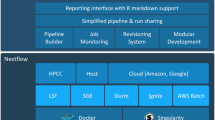Abstract
The publicly-funded effort to read the complete nucleotide sequence of the human genome, the human genome project (HGP), is nearing completion of the approximately three billion nucleotides of the human genome. In addition, several valuable sources of information have been developed as direct and indirect results of the HGP. These include the genome sequencing of model organisms (Escherichia coli, Saccharomyces cerevisiae, the fruit fly Drosophila melanogaster, the worm Caenorhabditis elegans, and the laboratory mouse), gene discovery projects (expressed sequence tags and full-length), and new high-throughput expression analyzes. These resources are invaluable in identifying the trascriptome and proteome—the set of transcribed and translated sequences. However, the bulk of the effort still remains—to identify the functional and structural elements contained within gene sequences. Addressing these challenges requires the use of high-performance computing. There are currently hundreds of databases containing biological information that may contain data relevant to the identification of disease-causing genes. Knowledge discovery using these databases holds enormous potential, if sufficient computing resources are utilized to process the overwhelming amounts of data. We are developing a system to acquire and mine data from a subset of these databases to aid our efforts to identify disease genes. A high performance cluster of Linux of workstations is used to perform distributed sequence alignments as part of our analysis and processing. This system has been used to mine the GeneMap99 database within specific genomic intervals to identify potential candidate disease genes associated with Bardet-Biedl syndrome (BBS).
Similar content being viewed by others
References
B. Agnew. When pharma merges, R&D is the dowry. Science, 287(5460):1952–1953, 2000.
S. F. Altschul, W. Gish, W. Miller, E. W. Myers, and D. J. Lipman. Basic local alignment search tool. J. Mol. Biol., 215:403–410, 1990.
J. B. L. Bard, R. A. Baldock, and D. R. Davidson. Elucidating the genetic networks of development: a bioinformatics approach. Genome Research, 8:859–863, 1998.
G. Bardet. Sur un syndrome d'obesite infantile avec polydactylie et retinite pigmentaire (contribution a l'etude des formes cliniques de l'obesite hypophysaire). Thesis: Paris Note: No. 479, 1920.
A. D. Baxevanis. The molecular biology database collection: an updated compilation of biological database resources. Nucleic Acids Research, 29(1):1–10, 2001.
A. Biedl. Ein Geschwisterpaar mit adiposo-genitaler Dystrophie. Dtsch. Med. Wschr., 48:1630, 1922.
C. Blaschke and J. C. Oliveros. Mining functional information associated with expression arrays. Functional Integrattive Genomics, 1:256–268, 2001.
E. A. Bruford, R. Riise, P. W. Teague, K. Porter, K. L. Thomson, A. T. Moore, M. Jay, M. Warburg, A. Schinzel, N. Tommerup, K. Tornqvist, T. Rosenberg, M. Patton, D. C. Mansfield, and A. F. Wright. Linkage mapping in 29 Bardet-Biedl syndrome families confirms loci in chromosomal regions 11q13, 15q22.3-q23, and 16q21. Genomics, 41:93–99, 1997.
M. Burset and R. Guigo. Evaluation of gene structure prediction programs. Genomics, 34:353–367, 1996.
R. Carmi, T. Rokhlina, A. E. Kwitek-Black, K. Elbedour, D. Nishimura, E. M. Stone, and V. C. Sheffield. Use of a DNA pooling strategy to identify a human obesity syndrome locus on chromosome 15. Hum. Molec. Genet., 4:9–13, 1995.
J.-M. Claverie. From bioinformatics to computational biology. Genome Research, 10:1277–1279, 2000.
S. R. Eddy. A review of the profile HMM literature from 1996-1998. Bioinformatics, 14:755–763, 1998.
B. Ewing and P. Green. Analysis of expressed sequence tags indicates 35,000 human genes. Nature Genetics, 25:232–234, 2000.
V. Ganti and R. Ramakrishnan. Mining very large databases. Computer, 38–45, August, 1999.
J. S. Green, P. S. Parfrey, J. D. Harnett, N. R. Farid, B. C. Cramer, G. Johnson, O. Heath, P. J. McManamon, E. O'Leary, and W. Pryse-Phillips. The cardinal manifestations at Bardet-Biedl syndrome, a form of Laurence-Moon-Biedl syndrome. New Eng. J. Med., 321:1002–1009, 1989.
J. L. Hennessy and D. A. Patterson. Computer Architecture: A Quantitative Approach, Morgan Kaufman Publishers, Inc., San Francisco, CA., USA. p. 7, 1996.
T. Jenssen, A. Laegreid, J. Komorowski, and E. Hovig. A literature network of human genes for high-throughput analysis of gene expression. Nature Genetics, 28:21–28, 2001.
D. P. Kreil and T. Etzold. DATABANKS-a catalog database of molecular biology databases. Trends in Biochemical Sciences, 24(4):155–157, 1999.
C. Kalb. When drugs do harm. Newsweek, p. 61, April 27, 1998.
E. S. Lander, et al. Initial sequencing and analysis of the human genome. Nature, 409:860–921, February 15, 2001.
K. Mykytyn, T. Braun, R. Carmi, N. B. Haider, C. C. Searby, M. Shastri, G. Beck, A. F. Wright, A. Iannaccone, K. Elbedour, R. Riise, A. Baldi, A. Raas-Rothschild, S. W. Gorman, D. M. Duhl, S. G. Jacobson, T. Casavant, E. M. Stone, V. C. Sheffield, Identification of the gene causing the human obesity syndrome, BBS4. June, 2001. To appear in Nature Genetics.
J. Ott. Analysis of Human Genetic Linkage, Johns Hopkins University Press, Baltimore and London, pp. 54–80, 1991.
S. L. Salzberg, D. B. Searles, and S. Kasif. Computaitonal Methods in Molecular Biology, Elsevier, Amsterdam, The Netherlands, pp. 228, 1999.
A. M. Slavotinek, E. M. Stone, K. Mykytyn, J. R. Heckenlively, J. S. Green, E. Heon, M. A. Musarella, P. S. Parfrey, V. C. Sheffield, and L. G. Biesecker. Mutations in MKKS cause Bardet-Biedl syndrome. Nature Genet., 26:15–16, 2000.
S. Solis-cohen and E. Weiss. Dystrophia adiposogenitalis, with atypical retinitis pigmentosa and mental deficiency, possibly of cerebral origin: a report of four cases in one family. Trans. Assoc. Am. Phys., 39:356–358, 1924.
R. H. Tamarin. Principles of Genetics, Wm. C. Brown Publishers. Dubuque, IA, 1996.
A. Watson. The universe shows its age. Science, 279(5353):981–983, 1998.
T.-L. Young, M. O. Woods, P. S. Parfrey, J. S. Green, E. O'Leary, D. Hefferton, and W. S. Davidson. Canadian Bardet-Biedl syndrome family reduces the critical region of BBS3 (3p) and presents with a variable phenotype. Am. J. Med. Genet., 78:461–467, 1998.
ftp://ftp.ncbi.nlm.nih.gov/blast/db/
http://www.ncbi.nlm.nih.gov/Entrez/
http://www.ncbi.nlm.nih.gov/genome/guide/human/
http://www.ncbi.nlm.nih.gov/Genbank/index.html
http://www.nhgri.nih.gov/HGP/
http://archive.uwcm.ac.uk/uwcm/mg/hgmd0.html
http://hmmer.wustl.edu/
http://www.java.sun.com/
http://www.genome.ad.jp/kegg/
http://research. marshfieldclinic.org/genetics/
http://www.informatics.jax.org/reports/homology map/mouse_human.shtml
http://www.ncbi.nlm.nih.gov
http://www.ncbi.nlm.nih.gov/entrez/Omim/mimstats.html
http://www.OpenPbs.org
http://www.genome.washington.edu/UWGC/analysistools/phrap.htm
http://www.ncbi.nih.gov/RefSeq/index.html
http://ftp.genome.washington.edu/RM/RepeatMasker.html
http://www.ncbi.nlm.nih.gov/SAGE/
http://searchlauncher.bcm.tmc.edu:9331/seq-search/struc-predict.html
http://genome.ucsc.edu/
http://eyeball.eng.uiowa.edu/clustering/
http://www.ncbi.nlm.nih.gov/UniGene/
Author information
Authors and Affiliations
Rights and permissions
About this article
Cite this article
Braun, T.A., Scheetz, T.E., Webster, G. et al. Identifying Candidate Disease Genes with High-Performance Computing. The Journal of Supercomputing 26, 7–24 (2003). https://doi.org/10.1023/A:1024417200364
Issue Date:
DOI: https://doi.org/10.1023/A:1024417200364




